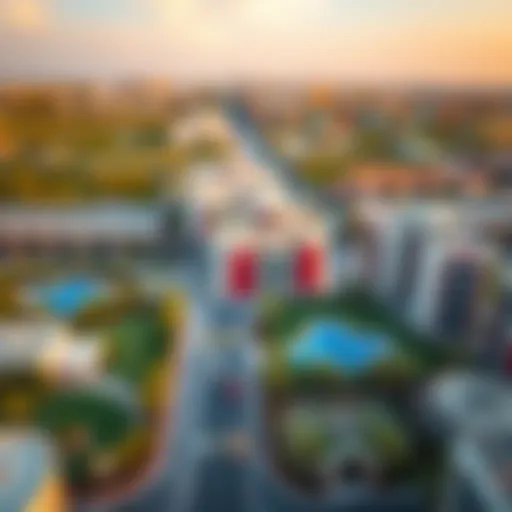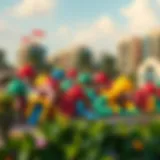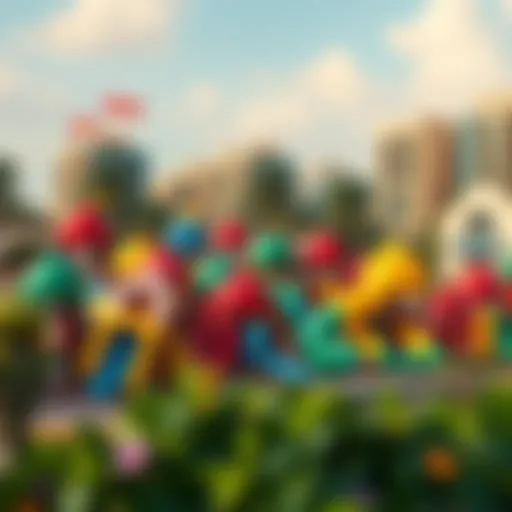Exploring Greens and Views: Nature in Urban Dubai


Intro
Dubai's image often conjures up images of glistening skyscrapers and bustling markets, but beneath this urban surface exists a rich tapestry where nature and architecture intertwine. This interplay creates vibrant green spaces that not only enhance the beauty of the city but also foster community interactions and well-being.
Intending to dig deeper, this article examines the subtle art of integrating greenery within the fast-paced urban life of Dubai. By exploring various neighborhoods, we can appreciate the profound relationship between urban development and environmental sustainability. The role of parks, gardens, and scenic views is more than just aesthetic pleasure; it significantly contributes to the quality of life for residents and visitors alike. Whether you are a homeowner, visitor, planner, or architect, understanding these elements of urban living is essential for appreciating the city's full essence.
We’ll also shed light on how community engagement thrives in these green areas, making Dubai not only a city of innovation but also a hub for shared experiences and interactions. This exploration will detail the diverse neighborhood features that make Dubai a unique blend of nature and modernity, focusing on landscaping highlights and architectural styles as key elements in creating these welcoming spaces.
Foreword to Dubai’s Urban Landscape
Dubai stands as a remarkable instance of urban development that neatly intertwines nature with architectural advancements. This city, often synonymous with glistening skyscrapers and luxurious shopping malls, also harbors a deep appreciation for green spaces. Few can deny that the juxtaposition of natural elements and urban settings can profoundly influence the quality of life for its inhabitants.
When exploring Dubai’s urban landscape, it's essential to recognize how the integration of greens enhances not only aesthetic appeal but also fosters community connectivity. Green spaces serve as vital lungs of the city, injecting fresh air into areas dominated by concrete and steel. These pockets of greenery are vital, offering places for relaxation, recreation, and social interaction amidst the bustling environment.
The primary benefits of incorporating these green elements into Dubai's urban fabric are manifold:
- Enhancement of Mental Well-being: Spaces adorned with trees, gardens, and parks have shown to reduce stress levels and improve overall mental health.
- Improving Air Quality: Plants naturally filter pollutants and produce oxygen, thereby enhancing the overall air quality in densely populated areas.
- Biodiversity Promotion: The introduction of green spaces encourages local wildlife, contributing to the city's ecological diversity.
- Climate Resilience: Strategically placed vegetation can also mitigate the urban heat island effect, providing respite from Dubai's sweltering climate.
The planning behind Dubai's landscape sheds light on various considerations, such as sustainability and utility. While growth is a constant, it’s crucial to maintain the balance between development and environmental stewardship.
"A green city is not just about plants and trees; it is about creating a habitat that nurtures life and interaction."
In essence, this section lays the groundwork for understanding how urban living in Dubai is harmoniously blended with nature. The way forward involves not just recognizing the significance of these spaces, but actively being a part of their evolution and rejuvenation.
With an eye on the future, the ongoing dialogue regarding greens in urban planning encourages stakeholders—be it homeowners, visitors, planners, or architects—to appreciate and perhaps advocate for a greener, more sustainable Dubai.
The Role of Greens in Urban Planning
Integrating natural elements into urban design is not just a luxury but a necessity. In Dubai, where rapid urbanization meets a growing appreciation for sustainability and well-being, the role of greens in urban planning has become increasingly significant. Green spaces foster a better quality of life by providing aesthetic value, recreational areas, and enhancing public health. When planners and architects weave greenery into their developments, they acknowledge the essential need for biodiversity alongside human habitation.
The benefits are multi-faceted:
- Improved Air Quality: Plants naturally filter pollutants from the air. More greenery means cleaner air for the citizens of Dubai.
- Habitats for Wildlife: Parks and gardens create sanctuaries for local wildlife, contributing to ecological balance.
- Social Interaction: Community parks become hot spots for social engagement, helping to foster a sense of belonging among residents.
- Economic Benefits: Green spaces can boost property values and attract tourism, essential for a city like Dubai which thrives on its diverse economy.
Urban planners must consider several elements:
- Proximity to residential areas: Greens should be easily accessible to encourage usage.
- Diversity of spaces: A mix of parks, gardens, and leisure facilities cater to different demographics and interests.
- Consideration of climate: Plants used should be suited to the local climate, ensuring sustainability and longevity.
"The balance between concrete and nature is crucial in creating livable cities."
Community input is just as important when discussing these aspects. Engaging residents in the planning process can ensure that the green spaces serve the needs of the people while also promoting sustainable practices.
In summary, incorporating greens in urban planning is vital for improving urban life in Dubai, driving both environmental and social benefits. It’s an ongoing journey that requires collaboration between architects, city planners, and the community.
Noteworthy Green Spaces in Dubai
Dubai is not just a city of towering skyscrapers and luxurious shopping malls; it also harbors a variety of notable green spaces. These parks and gardens serve not only as recreational areas but play a significant role in the urban ecosystem. By providing fresh air, shaded relaxation spots, and community gathering places, these green areas improve the quality of life for residents and visitors alike. As urbanization continues to expand, incorporating these spaces becomes paramount in fostering a sense of community and enhancing the overall aesthetic of the bustling city.
Parks: A Vital Element of Community Life
Al Barsha Pond Park
Al Barsha Pond Park, a delightful spot filled with lush greenery and scenic views, is a prime example of how parks benefit community life. One of its key characteristics is its expansive pond, which not only beautifies the area but serves as a habitat for various birds, making it a favorite for nature lovers and photographers alike. This park is popular for families and fitness enthusiasts as it features a dedicated jogging path and several picnic spots shaded by trees. The unique feature of a well-maintained promenade along the pond provides a peaceful escape from the city’s hustle. However, during weekends, it can get quite crowded, which might deter those seeking solitude.
Zabeel Park
Zabeel Park stands out as a significant leisure spot in Dubai. Its key characteristic is its vast garden spaces complemented with a variety of recreational facilities, including a dinosaur park that attracts children. It’s an ideal choice for anyone looking to unwind in a serene environment after a long week. The park’s unique feature is the Dubai Frame, an architectural masterpiece that offers panoramic views of the city. While Zabeel Park is a beloved spot, the limited shaded areas can make it less inviting during the sweltering summer months.
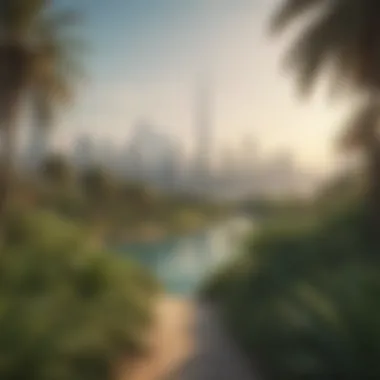

Dubai Marina Walk
Dubai Marina Walk is a stunning waterfront promenade enveloped in lively ambiance and greenery. This area serves multiple functions, from a strolling area to a venue for various dining options. Its distinct feature is the breathtaking views of the marina and skyscrapers lining the walk, making it also a favorite for those seeking a scenic backdrop for their outings. The vibrant atmosphere pulsates with life as couples and families take leisurely walks, contributing to a community-centric vibe. On the flip side, it can become bustling with tourists, which might overshadow the peaceful essence sought by some locals.
Gardens and Community Farms
Dubai Miracle Garden
The Dubai Miracle Garden is a breathtaking spectacle of horticultural creativity. One specific aspect that makes it stand apart is the sheer variety of floral displays; the garden boasts over 50 million flowers. This grand display is key to its popularity, luring both tourists and locals. The garden features themed gardens and floral sculptures that not only beautify the surroundings but also educate visitors on the importance of plant diversity. A potential drawback is the garden’s seasonal operation which may limit visitors during summer months.
UAE Community Gardens
UAE Community Gardens reflect a growing consensus on the importance of sustainable living. These gardens encourage residents to partake in urban farming, thus fostering a communal spirit. The key characteristic that makes them beneficial is the opportunity for community members to collaborate and learn about gardening and sustainability. Unique features often include workshops and volunteer days, which enhance community bonds. However, these gardens can face challenges, such as sustainable water usage and maintaining volunteer involvement, which may affect their overall success.
Green spaces in urban areas are not merely aesthetic elements; they are essential for fostering community interaction, enhancing mental well-being, and promoting biodiversity.
Architectural Innovations Integrating Nature
As Dubai continues to develop, the integration of greenery into the urban fabric has become ever more pressing. This section highlights how architectural innovations not only reshape the skyline but also ensure that nature finds a significant place in urban life. By prioritizing green spaces within building designs, the city aims to enhance quality of life, reduce environmental footprints, and foster a sense of community.
Green Building Initiatives
Dubai has seen a substantial surge in green building initiatives, with the municipality actively promoting sustainable construction practices. Buildings like The Sustainable City showcase how architecture can harmonize with nature. Developed to minimize energy consumption and maximize efficiency, these structures employ solar panels, rainwater harvesting systems, and natural ventilation.
Moreover, local regulations encourage using sustainable materials while promoting adaptive reuse of existing buildings to lessen ecological impacts. For instance, developers are trading traditional concrete for more eco-friendly materials like bamboo and recycled steel, thereby reducing carbon emissions.
Benefits of Green Building Initiatives:
- Reduced Operational Costs: Utilizing energy-efficient systems cuts down utility bills.
- Improved Air Quality: Enhanced ventilation and the inclusion of plants improve overall air quality for occupants.
- Increased Property Value: Sustainable buildings often fetch higher market prices and attract tenants who value eco-friendliness.
- Resilience Against Climate Change: Buildings designed with rising temperatures and extreme weather in mind offer long-term sustainability.
Biophilic Design Approaches
Biophilic design is not just a trend; it’s a fundamental shift towards understanding how people interact with their surroundings. This approach taps into our intrinsic connection with nature. Dubai’s latest projects are keenly focused on blurring the lines between indoor and outdoor environments. Think of spaces filled with plants, abundant natural light, and views of the skyline that include greenparks.
One excellent example is the Al Fayah Park, which hides beneath vibrant green canopies. Structures embedded with vertical gardens and living walls not only provide aesthetic appeal but also act as natural air filters. These living systems can significantly affect the microclimate, creating cooler spaces even in the hottest months.
"Integrating nature within urban architecture doesn't just beautify. It actually nurtures well-being, and people thrive in such environments."
The benefits of biophilic design intertwine with societal needs, prompting emotional responses that foster community interactions.
Key Aspects of Biophilic Design:
- Natural Light: Maximizing daylight reduces energy consumption and uplifts mood.
- Natural Elements: The incorporation of water features, plants, and natural materials fosters tranquility.
- Connection with Nature: View corridors and rooftop gardens tap into our primal desires, grounding city dwellers.
In summary, architectural innovations that infuse nature into urban design are paramount for Dubai’s future. By embracing green building initiatives and biophilic design, the city can safeguard its identity while ensuring environmental sustainability and enhancing its residents' overall quality of life.
The Synergy of Views and Greens
In the bustling metropolis of Dubai, the interplay between high-rises, lush greenery, and scenic vistas is more than just aesthetic; it's a cornerstone of urban well-being. With the city’s rapid development, the significance of harmonizing greens with urban views cannot be overstated. This synergy enriches the living experience and promotes environmental sustainability. Here, we explore the dimensions of this relationship, highlighting its benefits, practical elements, and critical considerations.
High-rise Living Overlooking Nature
High-rise buildings in Dubai often feature stunning designs that incorporate views of natural landscapes, whether it's the palm-lined Jumeirah coastline or the sprawling parks scattered throughout the city. Living in such spaces presents a unique advantage—residents enjoy dramatic vistas that can substantially elevate their daily experience. This connection to the broader environment not only bolsters mental well-being but also fosters a sense of place among inhabitants.
Take, for instance, the iconic Burj Khalifa—a towering achievement that offers perspectives over the entire city, merging urban sophistication with a backdrop of green spaces. Living in a building that overlooks a park, like Al Barsha Pond Park, creates a daily reminder of nature's presence, encouraging outdoor activities and community interaction.
Scenic Waterfront Developments
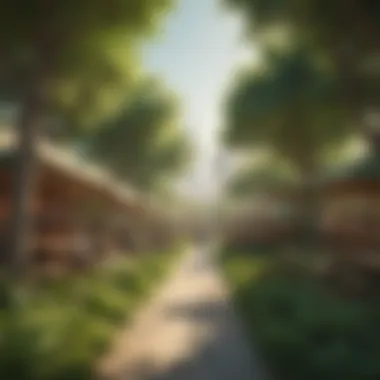

Dubai's shoreline is a marvel to behold, with waterfront developments marrying luxury living with breathtaking views. Areas like Dubai Marina exemplify this blend, featuring residential options where one can sip morning coffee while gazing at the turquoise waters of the Arabian Gulf. These developments often integrate promenade spaces and parks that are easily accessible, making them more than just luxury residences.
The combination of water and greenery provides myriad benefits, including temperature regulation and improved air quality. Additionally, such spaces cultivate social gatherings, with strolls by the water encouraging casual meet-ups and fostering community cohesion. Residents along the waterfront often report a greater quality of life, deriving pleasure from both the natural environment and the urban rhythm around them.
Balancing Urban Density with Green Areas
One of the paramount challenges in Dubai's urban planning has been striking the right balance between density and green spaces. As skyscrapers continue to rise, the demand for green areas grows in tandem. Incorporating parks and community gardens within heavily populated neighborhoods is crucial to maintaining quality of life in one of the fastest-growing cities in the world.
Land-use strategies must prioritize integrating greenery into urban networks. For example, the use of vertical gardens on building facades or rooftop parks can help mitigate issues related to space constraints.
Here are a few considerations for achieving this balance:
- Community Input: Engaging residents in the planning process ensures that green spaces meet their needs and preferences.
- Flexible Spaces: Designing multipurpose areas that can serve both recreational and leisure needs can maximize benefits within limited land.
- Sustainability Practices: Employing native plants and sustainable landscaping techniques enhances biodiversity and reduces water usage.
By maintaining this balance, Dubai can create a rich urban environment where people can thrive, surrounded by the soothing presence of nature.
“The true sign of intelligence is not knowledge but imagination.” – Albert Einstein. This notion rings particularly true in the context of integrating greens and views—for the harmonious coexistence of man and nature reflects both innovative urban planning and forward-thinking communities.
Community Engagement and Green Initiatives
Community engagement and green initiatives are essential threads in the intricate tapestry of Dubai’s urban landscape. They harness the power of collective action and deepen the relationship between residents and their natural environments. The integration of community initiatives not only beautifies urban spaces but also fosters a sense of ownership among residents. When locals actively participate in the greening of their surroundings, it cultivates a bond that strengthens communal ties, making neighborhoods feel like home rather than just places to live.
Moreover, these initiatives act as catalysts for broader environmental awareness. By involving residents in the upkeep and development of green spaces, people become more mindful of ecological issues, which is vital in a city that balances rapid urbanization with sustainability goals. Programs aimed at cultivating community responsibility promote green practices, showing that urban living doesn’t have to be at odds with nature.
Volunteer Programs for Urban Greening
Volunteer programs serve as a cornerstone for community engagement in promoting greenspaces in Dubai. These initiatives create opportunities for residents to physically contribute to the care and maintenance of local parks, gardens, and other green areas. Not only do volunteers get their hands dirty, but they also reap the benefits of physical activity, social interaction, and a true sense of accomplishment.
Key Aspects of Volunteer Programs:
- Hands-On Experience: Volunteers often participate in activities like planting trees, pruning shrubs, and creating community gardens. This hands-on work enhances their understanding of local ecosystems.
- Building Social Connections: Working together on greening projects fosters friendships among participants, leading to a more tightly knit community.
- Skill Development: Volunteers acquire new skills, such as gardening techniques and environmental education, that can benefit their personal lives and local community.
A notable program, the Dubai Parks and Recreation Department organizes regular clean-up drives and planting events, inviting the community to help maintain and expand the city’s green canopy. Last year alone, over two thousand residents participated in these efforts, with many citing it as a fun and enriching experience.
Community Events Promoting Sustainability
Community events centered around sustainability play a pivotal role in fostering a culture of environmental awareness in Dubai. These gatherings serve as platforms for spreading knowledge about sustainable practices while also celebrating the beauty of greenery.
From eco-fairs to nature walks, these events draw in crowds and spark conversations around important issues like conservation and biodiversity. Such engagements help demystify issues linked to landscaping and urban ecology, making them accessible and relatable to a wider audience.
Benefits of Community Events:
- Awareness Raising: Events create visibility for environmental issues and green initiatives, reaching a diverse group of people.
- Interactive Learning: Workshops on composting, sustainable gardening, or even local flora identification encourage learning through participation.
- Celebration of Nature: Festivals celebrating local plants or seasonal changes enhance appreciation for the natural world and remind residents of the beauty surrounding them.
A recent event, the Dubai Green Festival, showcased local businesses committed to sustainability while engaging residents in hands-on workshops on upcycling and eco-friendly practices. It proved to be a success, capturing the interest of families, students, and professionals alike.
In summary, community engagement and green initiatives are crucial in enhancing Dubai’s urban landscape. They not only beautify but also enrich the urban experience, turning the city into a more sustainable, inclusive, and vibrant place for everyone.
Challenges in Maintaining Green Spaces
Maintaining green spaces in Dubai is no walk in the park. These areas offer aesthetic appeal, environmental benefits, and recreational opportunities, but they also face a host of challenges that can compromise their vitality. Understanding these issues is crucial for homeowners, visitors, urban planners, and architects who are part of a community that values greenery in an increasingly urbanized environment.
The creation and upkeep of parks, gardens, and other green areas require more than just a design on paper. Environmental factors, for instance, play a significant role in determining the health of these spaces. It’s not just about planting a few trees and calling it a day; it involves understanding local climate conditions, soil types, and water availability.
Environmental Factors Affecting Gardens
In a city like Dubai, where desert landscapes dominate, the elements can be quite harsh. High temperatures and arid conditions put immense stress on vegetation.
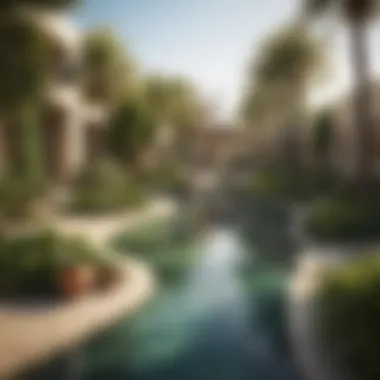

- Water Scarcity: Watering plants can become a balancing act. Agriculture and irrigation techniques that work elsewhere might not translate well here. Relying on excessive water usage can lead to deficits, making sustainable practices a necessity.
- Soil Quality: The native soil, often sandy and nutrient-poor, demands additional input to support lush gardens. Fertility treatments and soil amendments can be labor-intensive and require ongoing management.
- Pests and Diseases: The aforementioned environmental conditions can attract pests and diseases that challenge plant health, requiring active pest management strategies.
"The survival of green spaces hinges on a concerted effort to navigate environmental adversities, adapting our maintenance practices to the local realities."
Urban Development Pressures
As the city continues its meteoric rise with skyscrapers and infrastructure developments, green spaces often find themselves under increasing strain. Urban development pressures can lead to the loss of green areas or degradation of existing ones. Several factors play a role in this:
- Land Use Conflicts: With demand for real estate skyrocketing, developers may prioritize residential or commercial projects over the preservation of parks or green belts. This can create gaps in urban greenery that detract from community wellbeing.
- Construction Activities: Heavy machinery and construction activity disrupt local ecosystems. Soil compaction, pollution, and displacement of local flora can lead to diminished green spaces.
- Zoning Regulations: Sometimes outdated or insufficient zoning laws may fail to protect existing gardens and parks, making it easy for them to be replaced by new developments without consideration for community needs.
Ultimately, the continuous balance between urban expansion and the preservation of nature is a tightrope act. Striving to maintain existing green areas while welcoming innovation and construction is no small feat, but it is crucial for sustainable urban living in Dubai.
Future Trends in Dubai’s Green Landscape
The evolution of Dubai’s urban environment is not just a tale of soaring skyscrapers and sprawling malls. The future of its green landscape holds immense potential for the wellbeing of its residents and visitors. As urban areas continue to grow, it becomes increasingly essential to integrate nature into the architectural fabric of this bustling metropolis. By fostering an environment that prioritizes green initiatives and smart landscaping, Dubai can enhance the quality of life for everyone. Understanding these upcoming trends is crucial as it lays the groundwork for sustainable living in a city known for its rapid advancement.
Smart Landscaping Solutions
Incorporating technology within landscape design redefines the very premise of how we perceive green spaces. Smart landscaping solutions entail the use of advanced technology to optimize the maintenance and function of parks and gardens. For instance, irrigation systems equipped with sensors can gauge soil moisture levels and automatically adjust watering schedules, conserving water considerably. Environmentally friendly practices could integrate solar-powered lighting to enhance night-time visibility while minimizing energy consumption.
Moreover, the combination of Internet of Things (IoT) devices allows for real-time monitoring of plant health, enabling timely interventions when necessary. Such technologies not only promote sustainability but also reduce the workload on maintenance teams, allowing them to focus on creating even more engaging community spaces.
- Examples of smart landscaping solutions include:
- Automated irrigation systems
- Use of native plants that require fewer resources
- Vertical gardens utilizing smart technologies
These innovations not only address environmental concerns but also increase the aesthetic appeal of urban spaces, thereby captivating the attention of both residents and tourists. A greener, smarter Dubai may well become a benchmark for cities around the globe.
Community-oriented Green Projects
The heartbeat of any city lies within its community, and Dubai is keen to ensure that its residents play an active role in shaping the green landscape. Community-oriented green projects seek to foster social interaction and civic responsibility, transforming public spaces into vibrant hubs of activity and engagement. Such projects often encourage collaborative efforts among residents, local businesses, and government entities, creating an inclusive approach to urban green space management.
An example of this trend could be the planting of community gardens where families actively participate in gardening activities. It’s not just about beautifying neighborhoods; it’s about building relationships. These projects offer learning opportunities about sustainability and food resilience, bringing people together while also enhancing biodiversity.
- Key features of community-oriented initiatives:
- Participatory design sessions engaging local input
- Workshops focused on sustainability practices
- City-sponsored events that encourage local involvement
Together, these projects create a collective sense of ownership—and pride—in their surroundings, cultivating emotional bonds with the greenspaces they help to nurture. As community engagement flourishes, the overall urban ecology benefits, making Dubai not just a place to live, but a place to thrive.
“Creating a balance between urban life and nature is not just an ideal; it is a necessity for a sustainable future.”
As these future trends unfold, Dubai is poised to become a shining example of how thoughtful planning and community engagement can reshape urban landscapes, paving the way for greener cities. The blending of nature with innovation will no doubt play a huge role in the city’s identity in the years to come.
Finale: The Importance of Greens and Views
In the bustling metropolis of Dubai, the interplay between greens and views plays a profound role in not only enhancing the aesthetic appeal but also in enriching the lives of its residents and visitors. Green spaces offer much more than just beauty; they serve as vital elements promoting health, well-being, and community engagement. As the city continues to grow at a rapid pace, it is essential to prioritize the integration of nature amidst urban development.
Benefits of Greenery
Incorporating parks and landscaped gardens into the urban environment leads to numerous benefits, such as:
- Mental Health: Spending time in green areas has been proven to reduce stress levels and enhance mood. Nature provides a calming effect amidst the city's frenetic energy.
- Social Cohesion: Parks serve as gathering spots, where diverse community members can come together, fostering social ties and collaboration.
- Environmental Impact: Considered as lungs of the city, green spaces help in improving air quality and dissipation of urban heat, contributing to a sustainable ecosystem.
Importance of Views
The architectural layout of residential and commercial buildings in Dubai also reflects a significant consideration towards maximizing scenic views. Notably, properties that feature vistas of green parks, waterfronts, or landscaped gardens are generally more desirable. The views not only enhance livability but also possess economic implications:
- Property Value: Homes and offices overlooking green spaces often command higher prices, demonstrating the demand for quality living environments.
- Aesthetic Pleasure: An office with a view of the waterfront or a park can make the daily grind less mundane, improving overall workplace satisfaction.
"The essence of Dubai lies in its ability to merge urban magnificence with nature’s serenity, resulting in a habitat that nurtures life and joy."
Considerations for Future Development
As urban planners and architects look forward to the future, the challenge will be to strike a balance between growth and sustainability. Every new project should evaluate how it integrates greenery and maximizes vistas, while considering factors such as:
- Accessibility: Ensuring that green spaces are easily reachable to all community members enhances their usage.
- Diversity: Employing a variety of plant species can create more vibrant and resilient green spaces.
- Community Involvement: Engaging residents in the planning process fosters a sense of ownership and responsibility towards maintaining these areas.
In essence, the relationship between greens and views in Dubai is multidimensional, offering numerous advantages that go beyond the visual appeal. The commitment to preserving and expanding these vital elements of the urban landscape is crucial. As this fascinating city evolves, it is imperative to continue nurturing the vision of a future where nature can coexist harmoniously with modernization.



